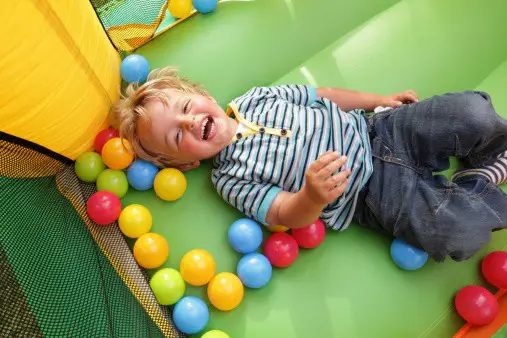The large balloon-like structures that are seen at parties and carnivals may have you questioning what bounce houses are made of. Even for small bounce houses there is a lot of fabric used.
Bounce houses are made from fire resistant, tightly woven materials. The small to medium sized residential bounce house is typically made from poly oxford material. Large residential bounce houses are usually made of nylon.
Have you ever wondered what the inflatable bounce houses are made from? How is it that a bounce house will hold air? Are the materials a bounce house is made from nontoxic and hypoallergenic? We will answer your questions in this post.
What are Bounce Houses Made Of?
The main materials used to make residential bounce houses are nylon and poly oxford. Commercial bounce houses are made from PVC vinyl. The residential bounce houses are lighter in weight than the commercial versions.
Oxford Cloth
Bounce houses made of poly oxford material that are 600 denier. It is often used for small to mid size residential play structures. This material is also called oxford cloth. Oxford cloth is made from polyester and/or nylon.
It is lightweight and relatively strong. Oxford cloth is also known to be water resistant and is used in many outdoor fabric applications. Even though it is durable, it may not be as durable as a nylon bounce house.
Nylon
Nylon is also used to make bounce houses.The nylon used must be at least 600 denier. Denier refers to the density or thickness of the threads used to weave the fabric. Nylon is typically heavier than oxford, but it is typically more durable, and thus is used for larger residential bounce houses.
PVC Vinyl Fabric
In commercial settings the bounce houses are often made with PVC Vinyl fabric. This PVC material is often 1500 denier, making it some of the toughest material to withstand heavy usage. The PVC Vinyl fabric is much heavier than oxford or nylon making it undesirable for residential usage.
Are Bounce Houses Made of Non-Toxic and Hypoallergenic Materials?
Though considered relatively safe, nylon, oxford and vinyl are all man-made materials. These materials can contain a variety of chemicals especially after they are treated with flame retardant. These chemicals may cause certain, sensitive, individuals to have a reaction.
Most retail bounce house descriptions claim that they are made of non toxic and hypoallergenic materials. For the most part they are considered safe for use.
If you are aware that you or your child have sensitivity to any of the fabrics, you may want to limit your time while using them, or find an alternative.
How Do They Make Bounces Fire Resistant?
The materials used to make bounce houses are resistant to fire. What this means is that they are slow to ignite when a flame is held to them. They will begin to melt when exposed to direct flame.
Bounce houses must be fire resistant. Most companies abide by the National FIre Protection Agencies flame retardant guidelines. Some bounce houses may be post treated with additional flame retardant.
How Does a Bounce House Retain Air?
Now that you know a little more about bounce houses, you may be wondering how they can maintain all the air.
A bounce house stays inflated due to the tightly woven material it is made from as well as a constant source of air being pushed into them from a blower or blowers.
They are not completely air tight. Once the blowers are turned off the bounce house will deflate within minutes.
Are Bounce Houses Water Resistant?
Bounce houses are water resistant. The man made materials used are noted for their ability to shed water. When these materials are woven densely water has a difficult time penetrating it.
Water resistant does not mean water can not get into it. If your water resistant bounce house gets soaked from a rain storm it is necessary to keep the bounce house inflated until you are certain there is no moisture inside the structure.
Some bounce houses are made to be waterproof. These structures often include pools or other areas of water play.
It is not necessary to keep them inflated when they have been wet. However you would want to dry the outer areas thoroughly before storage to prevent any mildew or mould growth.
Are Bounce Houses Easy to Clean?
Bounce houses are not difficult to clean. Soft bristled brooms and a leaf blower can be used to remove any loose debris. For all other cleaning use water and gentle detergents. Be sure to dry any liquids from the structure before you place it in storage.
Do not use harsh chemicals to clean the bounce house as these can weaken the materials and leave a residue. Some cleaner recommendations are
- Water
- Vinegar
- Dish soap without bleach
Remove any loose dirt with a soft broom or a leaf blower. Then wipe the entire surface area down with a diluted solution of water, vinegar and dish soap. After you have scrubbed the areas, use a clean cloth and fresh water to rinse the cleaned areas.
Be certain dry off the bounce house with soft and absorbent dry towels. You don’t want any moisture to be on the bounce house when it is stored or mold and mildew may set in. Dying it off will help keep your inflatable play structure clean and smelling good for a long time.
Conclusion
Now you know what bounce houses are made of. Hopefully this article allows you to steer clear of bounce houses that are made with materials unsuitable for your children, as oftentimes allergies are present.

